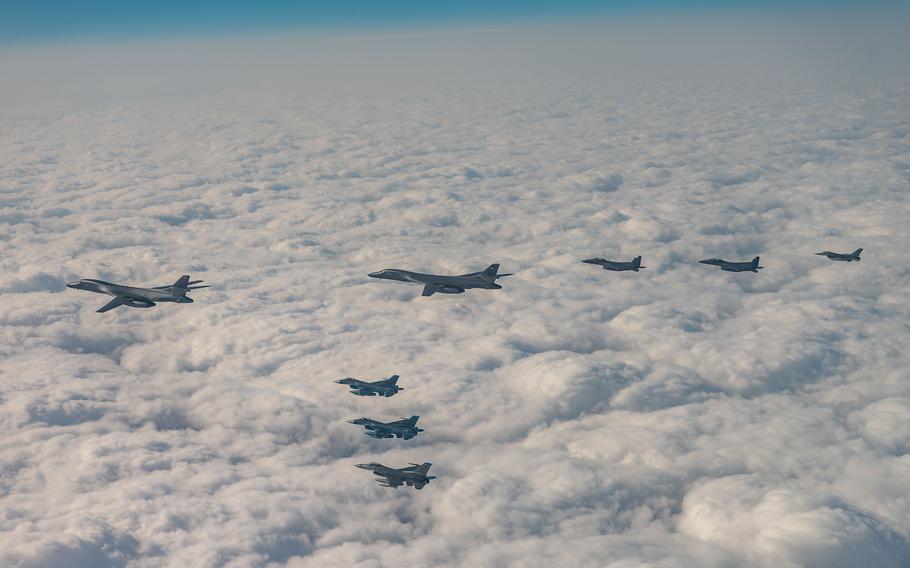
U.S. Air Force B-1B Lancers and F-16 Fighting Falcons fly alongside South Korean F-15Ks and Japanese F-2s during a trilateral air exercise near South Korea, Dec. 20, 2023. (Karla Parra/U.S. Air Force)
CAMP HUMPHREYS, South Korea — U.S., South Korean and Japanese aircraft for the second time conducted a bomber escort drill Wednesday after North Korea fired a pair of ballistic missiles earlier this week.
Two U.S. Air Force B-1B Lancers and two F-16 Fighting Falcons, along with two South Korean F-15Ks and two Japanese F-2s, flew east of Seoul’s Jeju Island south of the Korean Peninsula, according to a news release from the South Korean Ministry of National Defense on Wednesday.
The drill demonstrates the three nations’ “strong will and capability to jointly respond” to North Korea’s ballistic missile threats, the ministry said.
The U.S. Indo-Pacific Command in a news release Wednesday said, “Our international cooperation is reflective of our shared values and resolve against those who challenge regional stability.”
The drill comes three days after North Korea fired a solid-fueled Hwasong-18 intercontinental ballistic missile. The missile flew over 620 miles to a peak altitude of 4,050 miles before falling into the East Sea, or Sea of Japan. It was the communist regime’s fifth ICBM launch so far this year.
North Korea on Sunday fired a short-range ballistic missile that flew 354 miles before splashing down in the East Sea.
The show of force is the second such demonstration by the three countries. A U.S. B-52H Stratofortress bomber for the first time flew alongside South Korean and Japanese fighter jets Oct. 22 to demonstrate “their security cooperation and solidarity,” the South Korean Ministry of National Defense said at the time.
During an Aug. 18 summit meeting at Camp David, Md., President Joe Biden, South Korean President Yoon Suk Yeol and Japanese Prime Minister Fumio Kishida pledged to enhance their partnership in the wake of threats from North Korea.
“We are committed to pursuing enhanced ballistic missile defense cooperation to counter [North Korea’s] nuclear and missile threats,” the leaders said in a joint statement.
The trilateral pledge included the development of a real-time data sharing system on North Korea’s missile launches, which became operational Tuesday, allowing the U.S., South Korea and Japan to better detect and assess the regime’s missile launches.
Washington, Seoul and Tokyo established plans to hold multiyear military drills starting in 2024, according to a National Defense Ministry statement Tuesday.
North Korea’s state-run media outlet has condemned increased cooperation between the three partners as a ploy to destroy the regime. The missile data-sharing system is “a dangerous military action to drive the regional situation to a more serious phase of confrontation,” the Korean Central News Agency reported on Dec. 14.
“Now that the U.S. is making desperate efforts to seize the sovereignty of [North Korea]] and hold hegemony in the region … there can be no other way for ensuring peace and security in the Korean Peninsula and in the region,” the KCNA report said.